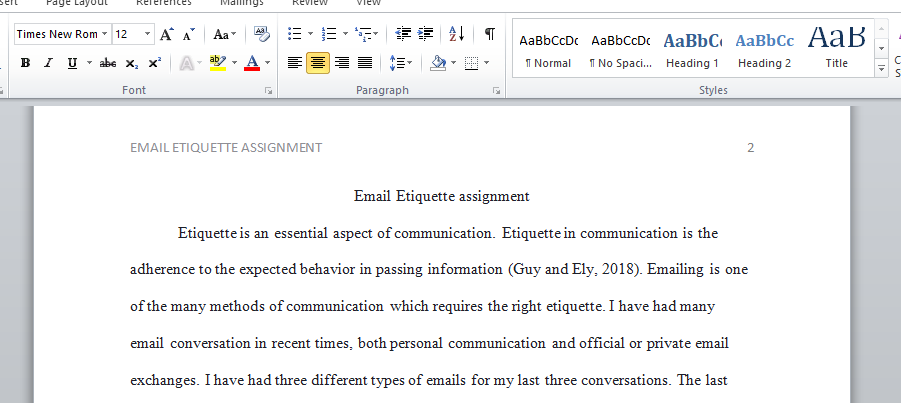Discuss Email etiquette
Examine three email exchanges that you recently had. Do they meet email etiquette standards 1 through 12? Where do they fall short? How could they be improved?
There is the skills box
SKILLBOX: E-MAIL VERSUS IN-PERSON COMMUNICATION E-mail is the most convenient way to communicate, but it is not always the best. The most meaningful communication is face-to-face and too much reliance on e-mail leads to fewer interpersonal interactions and a disconnected workplace. Tone of voice, facial expression, and body language transmit as much, if not more, information than words. This is why phone calls and face-to-face conversation are more powerful than e-mail and more effective in the following circumstances: 1) When a topic has many parameters that need to be explained or negotiated; 2) When the conversation is emotion-laden and requires sharing and listening to divergent points of view; CHAPTER 7 Digital Democracy 221 3) When the message is ambiguous such that the give-and-take of questions and answers is necessary for clarification; 4) When there are subtleties and nuances that become too complicated to communicate in the one-dimensional language of e-mails; and 5) When it is important to show commitment to the work of the team and their concerns. As items 1 through 5 show, complex issues and conflict-ridden problems are better discussed face-to-face, because in-person discussion provides an instantaneous opportunity to clear up confusion. Tone of voice, facial expression, and body language provide signals in addition to words. And in-person discussion avoids a flurry of back-and-forth e-mails that attempt to clear up confusion. Communicating in person makes it possible to see and sense the reactions of the others and to respond immediately in order to clarify meanings. E-mail Etiquette On the other hand, if the message is straightforward and can be communicated in a brief written message, then e-mail is an excellent channel for conveying it. These pointers ensure that the message that is intended is the message that is received. 1) Think of e-mail messages as simple memoranda. Each message should be clear, to the point, and unambiguous. 2) The subject frames the way the reader will interpret the message so use the subject line to state exactly the purpose of the message. 3) Be clear and to the point. Proof the message before sending it to make sure it conveys the desired message. Is it addressed to the correct recipients? Will it be sent to “reply all” or just to the sender? 4) When sharing someone else’s idea is the best way to communicate an idea, forwarding the text of another message is appropriate. Before forwarding, remove extraneous material that is not germane to the point at hand. 5) Avoid irony or sarcasm. Something that is funny in person may not be perceived as humorous in an e-mail. The one-dimensional nature of e-mail obscures humor and may cause the message to be misunderstood. 222 PART II Capitalizing on the Power of People, Money, Information 6) Acknowledge receipt of a message so the sender knows it has reached its destination. If no action is required, a simple “thanks” is sufficient. If a lengthy response is called for, acknowledge receipt and give the sender an approximate time to expect a full response. 7) Style matters: make sure spelling and punctuation are correct. A sloppy e-mail reflects badly on the sender and diminishes the message. 8) Do not use your nickname for an e-mail address. Use the name that recipients know and will recognize. 9) When writing a message, add the e-mail address of the recipient last. This prevents sending the message prematurely, before there has been time to edit and proof it. 10) Use a signature that contains contact information. This avoids follow-up e-mails to provide a phone number or address. 11) It is fine to write an e-mail when angry, but do not send it until sufficient time has passed to reconsider the message and edit it. 12) Be careful with confidential information. If it should not be forwarded, think twice before including it in a message. And do not send or forward messages that contain libelous, defamatory, offensive, racist, or obscene remarks. Remember, there is nothing private about e-mail. E-mail Policies and Best Practices 1) In general, use official e-mail accounts for official business. Personal e-mail account use for official business can conflict with existing laws and policies pertaining to public document retention. 2) Keep official e-mails official by limiting the inclusion of personal communication. Mixing the two can lead to the potential disclosure of personal information and reflect poorly on the organization. 3) Remember that each government has policies related to preserving and archiving e-mail communication. Employees should familiarize themselves with those policies to ensure compliance. Just because an e-mail is deleted by a user does not mean that it no longer exists. It may remain available to internal or external information requests. CHAPTER 7 Digital Democracy 223 NOTES 1. Sharon Begley, “Analysis: IT Experts Question Architecture of Obamacare Website,” Technology News (October 5, 2013) http://www.reuters.com/
Answer preview:

Words:1160
